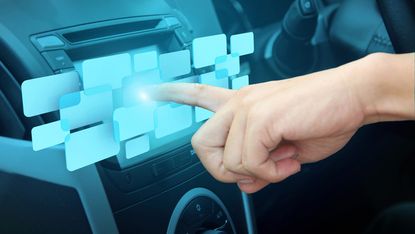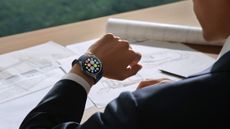In-car technology will inform the very design of your car's interior over the next decade or two, which means it'll all look very different to now…
Do you remember in the Max Power era when the perceived quality of your in-car tech was calculated by whether or not you could answer “yes” to the question: is there more room for speakers and sub-woofers in your car than passengers?
Well, thankfully, those days are gone and we're looking at a much more intuitive and integrated in-car future than we ever imagined during those laddish nights of car-park cruise culture. The way a car interior looks from a driver's point of view has remained largely unchanged in the last half a century. There have been developments over the years but, rather than smack-across-the-head changes, these have been more about steady reinvention anchored to the principle must-haves of a steering wheel, dials for speed, revs, fuel and temperature, climate controls and some sort of entertainment unit. Now, that's all about to change…
Quick dash
What we, as drivers, need from our vehicle's in-car tech is moving on significantly as connected-everything gathers momentum. Google's self-driver already has a removable steering wheel, so it's easy to imagine that even that mainstay instrument could eventually retract away into the dash when it's not needed, as your autonomous car zips you around. While your car is talking with a city's infrastructure to work out your best route to the office, you'll need to find other ways to entertain yourself on the move.
Think about it, if your car is doing things such as communicating with other vehicles to work in conjunction with them, caravanning like a road train coupled together via a data connection in order to travel around as a pack, what are you as the 'driver' going to do?
- If you love cars as much as we do, read our recent review of the stunning Ford GT
Look at Mercedes' much-lauded concept the F 015 Luxury in Motion as an example of where we might be by 2030. Mercedes imagined the world by that time to have accepted autonomous driving as normal. If situations arise when it isn't fun to drive yourself, like traffic jams, the car will just take over and do it for you.
It also supposed that, inversely proportional with the inevitable ever- growing urbanisation, the shrinking of personal space and lack of one's own time will occur – which broadly means that as the real world's urban areas get more congested, you'll have less and less opportunity to find room for yourself.
With that in mind, the F 015's cabin maximises the time you get to spend in your own environment. So your Merc drives itself to pick you up, the doors open and you glide inside. There, you can sit back and consume your media via the six eye-tracking-controlled screens, or just tune out for the duration of your journey.
Your car, don't forget, needs nothing more from you than an input to state where you're going – it'll sort the rest.
So there you are, in your little protective bubble, being chauffeur- driven by your car. This is your future. Do you like it?

The here and now
This might all sound a bit too sci-fi, but it will be here sooner than you think. The big steps that we're about to see taken by car manufacturers are already well underway in R&D labs the world over. As Jim Buczkowski, Director of Electrical and Electronics Systems, Research and Advanced Engineering at Ford, explained, "Voice recognition started as a great way to reduce driver distraction, and we've researched that a lot. Situational awareness, which means having your eyes up, looking around, is most important for safety. Heads-Up Display can do that, because the display is up closer into the field of view, so you don't need to look down."
The in-car tech that seemed so very far away only a few years ago is all now quite imminent indeed. Take augmented reality, for example. Most of us think about AR going only as far as an app that shows the way to the nearest restaurant or bar. But in the car, it'll do so much more. It's not that much of a leap to finding you with windscreens that will no longer be merely your windows to the outside world, but rather your guide. The windscreen will become a full-screen Heads-Up Display (HUD), feeding you info that you need to see, right where you want it the most: slap-bang in front of you.
Your GPS will no longer be a small screen suckered to the glass or popped into the dash; instead, it'll utilise the whole expanse of your windscreen, showing you useful information like direction arrows or warning signs as if they were painted on the actual road in front of you.The centre cluster around your steering wheel will no longer be the prime area for information relay; instead, all of the alerts and updates will be displayed across your windscreen.
Manufacturers' prime concern, from a usability standpoint, is to make you a safer driver, so keeping your eyes looking up and forward for as much of the time that you're behind the wheel as possible is a huge goal for all of the technology that's being developed. To this end, voice commands will get even more usable, as the best way for you to get what you want in your cabin is to say it out loud, rather than taking your eyes from the road to search for an environment setting or a headlight switch-gear.
Already, this future is beginning to show in the real world. Tesla has a huge 17-inch touchscreen in its Model S, tilted towards the driver for rich content and mobile connectivity. And Audi is about to introduce the Virtual Cockpit with its 2015 TT, a 12.3-inch screen that sits behind the steering wheel in place of traditional dials, giving drivers the option to choose between an infotainment setting that brings functions such as the navigation map to the fore, or a more normal dial set-up (the TTS model has a virtual rev counter right in the middle).

This tech was still a concept just a few years ago – when Porsche showed its 2012 Sport Turismo vision of the future, there sat a similar TFT screen, only that one also had a pair of screens to feed in the images relayed from exterior mirror cameras. It's rare for Porsche to do a concept but when it does, you can be pretty sure it's confident that what you're shown will become reality, so keep an eye out for those cameras.
The cabin layout that you're so used to is already changing at a faster pace than it ever has before. Connectivity is the biggest thing happening in-car right now – your apps already talk to your car in more ways than ever. This is a huge melting pot where auto makers and tech companies are coming together, and one for which the auto side doesn't need to do too much development of its own – your phone does all the heavy lifting, your car just needs to facilitate it.
To exemplify just how Really Big and Important this area of business is for the car industry, think about what it means that the President of the Fiat Chrysler group, Sergio Marchionne, recently spent a week in Silicon Valley taking not only a ride in Google's autonomous car, but also the opportunity to meet with Apple head honcho Tim Cook and Tesla founder Elon Musk. Cook is apparently, “interested in Apple's intervention in the car”, according to Marchionne. And of Musk, he said that he's “incredibly impressed with what that kid has done”.
The fallout from these meetings obviously opens up many potential possibilities of cross-pollination for all parties, especially with Apple having already been so open about iOS auto integration with CarPlay. Fiat, don't forget, is the parent company of Ferrari, where you've seen a lot about CarPlay. And it's guaranteed that many similar meetings have happened with car manufactures and tech companies the world over. It's extremely exciting.
But things get even more intriguing when you listen to the whispers that Apple is looking at a very real future of becoming an auto maker itself, with an electric car. If it moves into that area, you can imagine how wild the possibilities for in-car tech will be then.
If Apple makes a car, will you get the ever-present start-up 'bong' chime when you turn the key? We kind of hope so.
Like this? Why not read our feature on the future of tech in sport?
Image credits: transportation, touch screen, future technology and vehicle concept from Shutterstock



